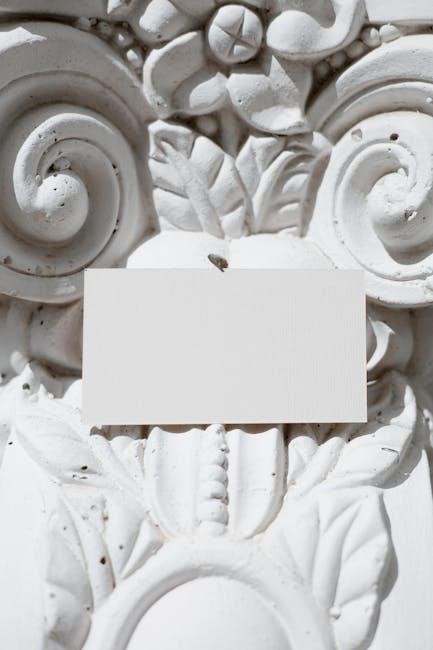
Blank Chord Chart PDF: A Comprehensive Guide
A blank chord chart PDF is a fundamental resource for musicians. It allows personalized notation of chord voicings‚ finger placements‚ and song structures. This comprehensive guide will explore how to effectively use these charts.
Blank chord charts are invaluable tools for musicians of all levels‚ serving as customizable templates for organizing and documenting musical ideas. These charts provide a visual framework for mapping out chord progressions‚ voicings‚ and finger placements‚ making them essential for songwriting‚ practice‚ and music education. Whether you’re a guitarist‚ bassist‚ ukulele player‚ or any other musician utilizing chords‚ blank chord charts offer a flexible way to capture and recall your musical arrangements. Their simplicity and adaptability make them a cornerstone of effective musical organization and creativity‚ fostering a deeper understanding of harmony and chord structures. They are readily available in PDF format.

Understanding Chord Diagrams
Chord diagrams are visual representations of finger placements on an instrument’s fretboard‚ essential for learning and playing chords. Understanding their anatomy and how to read them is crucial for any musician.
Anatomy of a Chord Diagram
A typical chord diagram visually represents the fretboard of a stringed instrument. Vertical lines indicate strings‚ while horizontal lines denote frets. Numbers may appear‚ indicating which finger should press down on the string at that fret. An “X” above a string means it should not be played‚ and an “O” indicates an open string. The thickest horizontal line at the top of the diagram represents the nut of the instrument. Understanding these elements is essential for deciphering and utilizing chord diagrams effectively for learning and playing music. It’s the foundation of understanding chord shapes.
Reading Chord Diagrams Effectively
To read chord diagrams effectively‚ start by identifying the nut and strings. Note the numbers indicating finger placement; 1 is typically the index finger‚ 2 the middle‚ 3 the ring‚ and 4 the pinky. The “X” symbols above strings mean do not play‚ while “O” symbols indicate open strings. Pay attention to any numbers to the left of the diagram indicating the starting fret if it’s not at the nut. Practice visualizing the finger positions on your instrument. Consistency in interpreting diagrams will lead to faster chord learning and smoother transitions.
Benefits of Using Blank Chord Charts
Blank chord charts provide numerous benefits. They aid in memorizing chord shapes‚ creating custom progressions‚ and serving as an invaluable teaching tool. They are versatile and adaptable to various instruments.
Memorizing Chord Shapes
Using blank chord charts is an effective method for memorizing chord shapes. By repeatedly drawing and filling in the diagrams‚ you reinforce the finger placements in your muscle memory. This active recall technique strengthens the connection between visual representation and physical execution.
Consistent practice with these charts leads to quicker recognition and recall of chord voicings. Blank charts allow you to focus on challenging or new chords. This targeted approach accelerates the learning process and improves your overall understanding of the instrument’s fretboard. You will enhance your ability to play more fluently.
Creating Custom Chord Progressions
Blank chord charts are invaluable for crafting unique chord progressions. They provide a visual space to experiment with different chord sequences. This allows musicians to map out songs and explore harmonic possibilities. By sketching chord diagrams‚ you can easily visualize relationships between chords‚ facilitating creative songwriting.
These charts help to identify inversions‚ substitutions‚ and voicings. This supports the creation of interesting and unconventional musical pieces. Musicians can use them to develop their signature sound. The blank format encourages exploration and discovery. It is a powerful tool for unlocking your creative potential.
Teaching and Learning Tool
Blank chord charts are excellent teaching aids for music instructors. They facilitate student understanding of chord structures and relationships. Teachers can use these charts to demonstrate new chords and voicings. Students can fill them out to reinforce their learning. This active participation enhances comprehension and retention.
These charts also allow customization to suit individual learning styles. Instructors can create worksheets tailored to specific lessons. They can also use them to assess a student’s progress. The visual nature of chord diagrams makes learning more accessible; It is a valuable resource for both educators and students. It promotes effective musical education.
Types of Blank Chord Chart Layouts
Blank chord chart layouts vary to suit different needs. Common types include vertical‚ horizontal‚ and multiple-diagram formats. Each layout offers unique advantages for organizing and visualizing musical information effectively.
Vertical Chord Charts
Vertical chord charts are a popular layout choice for musicians. They display chord diagrams in a vertical stack‚ often resembling a column. This format is space-efficient‚ allowing many chords to be presented on a single page. Vertical layouts are particularly useful for quickly referencing a series of chords in a song or progression. The stacked arrangement aids in visually comparing different chord shapes and identifying common fingerings. This chart type is beneficial for creating cheat sheets and practicing chord transitions. Vertical chord charts are easily adaptable for various instruments‚ including guitar‚ ukulele‚ and bass. Their compact design makes them ideal for binders and notebooks.
Horizontal Chord Charts
Horizontal chord charts offer an alternative layout where chord diagrams are arranged side-by-side in a row. This format is beneficial when focusing on a specific chord progression or melodic line. The horizontal arrangement mimics the linear progression of music‚ making it intuitive to follow along with a song. This layout provides ample space for annotations and additional information alongside each chord diagram. Musicians often use horizontal charts to map out entire song sections or verses. The extended width allows for detailed finger placement markings and other performance notes. Horizontal chord charts are well-suited for creating visually appealing and informative reference sheets‚ enhancing practice and memorization.
Multiple Chord Diagrams per Page
Layouts featuring multiple chord diagrams per page maximize space and provide a comprehensive overview. This format is ideal for compiling a wide range of chords within a single document. These layouts are beneficial for creating chord dictionaries or reference sheets for various keys or musical styles. Musicians can efficiently organize and access numerous chord voicings. The condensed format encourages exploration and experimentation with different chord combinations. These charts are particularly useful for teaching purposes‚ allowing instructors to present a variety of chord options in a clear and concise manner. Multiple diagrams facilitate easy comparison and analysis of chord structures. This layout is excellent for quick reference during practice or performance.

Where to Find Blank Chord Chart PDFs
Numerous online resources offer blank chord chart PDFs for free download. Customizable templates are also available‚ allowing musicians to create personalized charts tailored to their specific needs and preferences.
Online Resources for Free Downloads
The internet is brimming with websites offering free blank chord chart PDFs. These resources cater to various instruments‚ including guitar‚ bass‚ and ukulele. Many sites provide printable sheets with different layouts‚ such as vertical‚ horizontal‚ or multiple diagrams per page. Look for sites dedicated to music education‚ guitar tabs‚ or songwriting resources. Some software and apps also offer downloadable PDF templates. Ensure the website is reputable and the download is safe before proceeding. Often‚ these free resources provide a great starting point for organizing your musical ideas and chord knowledge.
Customizable Templates
Beyond readily available PDFs‚ customizable templates offer unparalleled flexibility. Several websites and software programs allow users to create personalized blank chord charts. These platforms often let you adjust the number of strings‚ frets‚ and chord diagrams per page. Some even offer options to add text fields for song titles‚ capo positions‚ or other relevant notes. Customizable templates are perfect for creating chord charts tailored to specific instruments or teaching needs. This level of personalization ensures the chart perfectly suits your workflow and enhances your ability to learn and create music effectively.

Printing and Using Your Chord Charts
Once you have your blank chord chart PDF‚ printing and effective use are key. Optimize print settings for clarity and legibility. Filling out the charts accurately will maximize their utility for practice and songwriting;
Optimizing Print Settings
To ensure your blank chord chart PDF is highly usable‚ optimizing print settings is essential. Select a high-resolution print option to maintain clear lines and avoid blurry diagrams. Choose a paper size that suits your needs‚ typically A4 or Letter. Consider printing in black and white to save ink‚ especially if color isn’t crucial. Adjust margins to maximize the printable area and prevent cutoff. Preview the document before printing to confirm layout and readability. For frequent use‚ consider printing on thicker paper for durability. By optimizing these settings‚ your chord charts will be easy to read and use for practice.
Filling Out the Charts Effectively
Effectively filling out blank chord charts requires a systematic approach for clarity and usability. Use a pencil for easy corrections and updates as your understanding evolves. Clearly mark the root note and chord quality (major‚ minor‚ etc.) for quick reference. Indicate finger placements using numbers or symbols‚ ensuring consistency across all diagrams. Note any alternative bass notes or slash chords to expand your harmonic vocabulary. Keep the writing neat and organized to avoid confusion during practice or performance. Consider color-coding different chord types or voicings for visual distinction. Regularly review and update your charts to reflect your current repertoire and musical goals‚ promoting long-term learning.

Using Blank Chord Charts for Different Instruments
Blank chord charts are versatile tools applicable across various instruments. Their adaptable design allows musicians to notate chord voicings and fingerings specific to instruments like guitar‚ bass‚ and ukulele.
Guitar (6-String and 7-String)
For guitarists‚ blank chord charts are invaluable for documenting chord voicings and experimenting with new sounds. Whether you’re playing a standard 6-string or exploring the extended range of a 7-string‚ these charts provide a visual space to map out finger placements on the fretboard. This includes marking root notes‚ intervals‚ and any altered tunings used. Guitarists can use these charts to learn new chords‚ create custom progressions‚ and visually organize their musical ideas. The charts offer a streamlined method to understand chord structures and discover unique voicings.
Bass Guitar
Bass guitarists benefit significantly from using blank chord charts to map out bass lines‚ root notes‚ and chord variations. Bassists often use simplified chord shapes and inversions. Blank charts allow bass players to visually organize these patterns and understand their relationship to the full chord. This becomes especially useful when creating walking bass lines. The charts allow visual representation of root movements and passing tones. Bassists can use these charts to document chord positions‚ scale patterns‚ and create bass-specific chord voicings. This is helpful for both 4-string and 5-string bass.
Ukulele
Ukulele players find blank chord charts invaluable due to the instrument’s unique tuning and chord shapes. The reduced number of strings simplifies chord diagrams. However‚ the compact fretboard necessitates clear visual representation. Blank ukulele chord charts are ideal for documenting common ukulele chords and variations. This includes different inversions and voicings that might not be immediately obvious. Ukulele players can use these charts to explore chord progressions specific to the instrument’s sound. This aids in writing original songs or adapting existing songs for the ukulele. The visual aid supports learning and memorizing new ukulele chords.